Danish Signaling, Reduced Lineside Signaling
Updated 000224

Contents
Introduction
Signal Types
"Reduced" Signal Aspects and Indications
"Stop" (Danish: "Stop")
"Stop and
Proceed" (Danish: "Stop og Ryk Frem")
"Proceed" (Danish:
"Kør")
"Proceed Through"
(Danish: "Kør Igennem")
"No Passing" (Danish:
"Forbikørsel Forbudt")
"Pass with
Caution" (Danish: "Forsigtig Forbikørsel Tilladt")
"Pass" (Danish: "Forbikørsel
Tilladt")
"Canceled" (Danish:
"Signalet Annulleret")
Reduced Lineside Signaling Usage
Omitting
Speed Signaling
Omitting
Advance Signaling
"Proceed
Through" in Platform Exit Signals
Platform
Exit Signals as Station Block Signals
To
or From Ordinary Signaling
Peculiarities

Introduction
Reduced Lineside Signaling was a signaling concept planned to be
used on all new signal installations from the late 1990s and onwards. The
basic idea of Reduced Lineside Signaling was to utilize the Danish mainline
Automatic Train Control system's cab signaling to reduce the need for lineside
signaling. Reduced Lineside Signaling roughly removed all speed and advance
signaling, leaving only the "Stop" and "Proceed" aspects (red and green)
in the main signals. Trains without ATC were to be run at a maximum of
80 km/h on the line and 40 km/h within station limits.
Reduced Lineside Signaling was to be introduced on the Copenhagen Airport
Link, but be used in all future installations on lines with ATC. Following
shortly after was the resignaling of the Århus station. The Reduced
Lineside Signaling caused some debate, leading to Århus stations
being converted to ordinary signals (a rather simple matter as the case
was), except for two Exit Signals still being without advance signaling
capability. On the Airport Link the debate lead to changes in operational
rules, to lineside signs and markers, and to some extent also to the signals.
It was then decided to start a research project on the signaling concept
of the future, and to leave this one line as it was until the research
project has come to a conclusion. The Airport Link is therefore to be considered
a loner not to be repeated, and possibly to be changed within the next
years.
Signal Types
Entry, Entry Block, Exit Block, Exit and Automatic Block Signals are a
standardized 2-lamp type, only capable of displaying "Stop", "Stop and
Proceed" and "Proceed", i.e. without facilities for speed signaling or
advance signaling. Physically the signals deviate slightly from the modern
standard type by having the lamps spaced slightly farther apart. The increased
lamp spacing is entirely due to different components being used and has
nothing to do with the Reduced Lineside Signaling as such.
Signal types are as on conventional signals marked by a plate on the
signal mast. Entry Signals always carry a Station Name Sign. Exit Block
Signals always carry a Reduced Speed Sign and Exit Signals for the right
main track carry a Switch Limit Sign:





Platform Exit and Dwarf Signals are identical to regular signals. Platform
Exit Signals always carry a Reduced Speed Sign on their mast:


"Reduced" Signal Aspects and Indications
The term Prescribed Speed as used
below is the speed prescribed in the Employee Timetable (Danish equivalent:
Tjenestekøreplanens Indledende Bemærkninger, TIB) or Track
Bulletins (Danish Equivalent: La). Prescribed speed in the Employee Timetable
is currently 60 km/h throughout the Øresund Line.
Trains with active cab signals may receive
a more favorable indication than what lineside signals indicate. Cab signal
will govern in such cases.
"Stop" (Danish: "Stop"
| Signal Type |
Entry
Signal |
Entry
Block
Signal |
Platform
Exit
Signal |
Exit
Block
Signal
|
Exit
Signal
|
Automatic
Block
Signal
|
| |

|

|
 |
 |
 |
 |
|
|
X |
X |
X |
X |
X |
X
|
"Stop and Proceed" (Danish: "Stop og Ryk Frem")
When the current operational rules for Reduced Lineside Signaling were
written, it was decided that it was undesirable to have Entry and Entry
Block Signals displaying "Stop and Proceed" without the upper yellow light
(and thus not being clearly marked as Entry or Entry Block Signals). The
"Stop and Proceed" aspect has therefore been blocked in these signals.
| Signal Type |
Entry
Signal |
Entry
Block
Signal |
Platform
Exit
Signal |
Exit
Block
Signal
|
Exit
Signal
|
Automatic
Block
Signal
|
| |
N/A
|
N/A
|
 |
 |
 |
 |
-
Stop, then proceed with caution to next Main Signal
|
|
|
X |
X |
X |
X
|
-
Maximum speed 40 km/h (25 mph)
|
|
|
X |
X |
|
|
-
Maximum speed 60 km/h (40 mph) - or less if so prescribed
|
|
|
|
|
X |
X
|
-
Route cannot be guaranteed to be unoccupied
|
|
|
X |
X |
|
|
"Proceed" (Danish: "Kør")
| Signal Type |
Entry
Signal |
Entry
Block
Signal |
Platform
Exit
Signal |
Exit
Block
Signal
|
Exit
Signal
|
Automatic
Block
Signal
|
| |

|

|
 |
 |
 |
 |
-
Proceed to next Main Signal
|
X a) |
X |
X |
X |
X |
X
|
|
|
X |
X |
X |
X |
X |
X
|
-
Trains without active Cab Signal: Prepare to stop at next Main Signal
|
X a) |
X |
X |
X |
X |
X
|
-
Trains without active Cab Signal: Maximum speed as prescribed
|
X |
X |
X |
X |
X |
X
|
a) Deviation from ordinary rules: Entry Signal without Speed Indicator
may precede Entry Block Signal, so that "Proceed" as shown means
"Clear to Entry Block Signal only"
"Proceed Through" (Danish: "Kør Igennem")
| Signal Type |
Entry
Signal |
Entry
Block
Signal |
Platform
Exit
Signal |
Exit
Block
Signal
|
Exit
Signal
|
Automatic
Block
Signal
|
| |
N/A
|
N/A
|
 |
N/A
|
N/A
|
N/A
|
|
|
|
|
X |
|
|
|
|
|
|
|
X |
|
|
|
-
Exit Block Signal (if any) and Exit Signal show "Proceed"
|
|
|
X a) |
|
|
|
-
Trains without active Cab Signal: Maximum speed as prescribed
|
|
|
X |
|
|
|
a) Deviation from ordinary signaling rules: Exit Block Signal in traditional
installations show "Proceed Through" in this situation.
"No Passing" (Danish: "Forbikørsel Forbudt")
| Signal Type |
Platform
Exit
Signal |
Dwarf
Signal
|
| |
 |
 |
|
|
X |
X
|
"Pass with Caution" (Danish: "Forsigtig Forbikørsel
Tilladt")
| Signal Type |
Platform
Exit
Signal |
Dwarf
Signal
|
| |
 |
 |
-
The signal may be passed with caution. The route may be occupied
|
X |
X
|
"Pass" (Danish: "Forbikørsel Tilladt")
| Signal Type |
Platform
Exit
Signal |
Dwarf
Signal
|
| |
 |
 |
-
The signal may be passed. The route is clear
|
X |
X
|
"Canceled" (Danish: "Signalet Annulleret")
| Signal Type |
Platform
Exit
Signal |
Dwarf
Signal
|
| |
 |
 |
-
Pretend the signal does not exist. The canceled signal is not in itself
a permission to start switching
|
X |
X
|
Reduced Lineside Signaling Usage
Omitting Speed Signaling
The omission of speed signaling means that trains without cab signals must
proceed at the most restrictive speed of the possible routes from the signal.
On the existing installation this means 60 km/h in most cases:
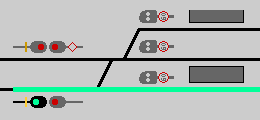
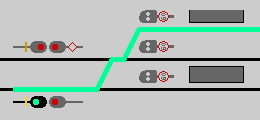
In station exit ends the lack of speed signaling is no different from
traditional signaling.
Omitting Advance Signaling
Reduced Lineside Signaling features no advance signaling. A train without
active ATC must always approach a Main Signal prepared to stop. The traditional
rigid naming and interpretation of signal types has been carried on into
the Reduced Lineside Signaling concept:






An exception to this rule is that Platform Exit Signals shows "Proceed
Through" when a primary exit route past the Exit Signal is clear. The reason
for this exception is technical, since the Platform Exit Signal ATC interface
does not allow for easy omission of the "Proceed Through" aspect if reasonable
functionality is to be retained:

"Proceed Through" in Platform Exit Signals
The use of the "Proceed Through" aspect in Platform Exit Signals is identical
to similar uses in traditional signaling installations, though in the total
context the "Proceed Through" aspect seems somewhat out of place and inconsistent
with the Reduced Lineside Signaling concept. "Proceed Through" from a Platform
Exit Signal indicates that a primary exit route has been set and that signals
in the station exit end show "Proceed" or better, i.e. Platform Exit Signals
show "Proceed Through", Exit Block and Exit signal shows "Proceed". The
use of the "Proceed Through" aspect with the Exit Block Signal only at
"Proceed" is inconsistent with ordinary signaling but has been permitted
by special instructions:
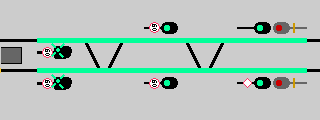
In all other cases the Platform Exit Signal shows only "Proceed", i.e.
in case of the exit route not being clear past the Exit Signal:
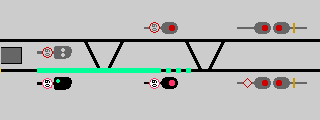
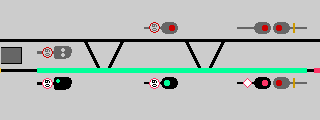
Or the exit route being a secondary route:
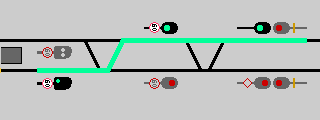
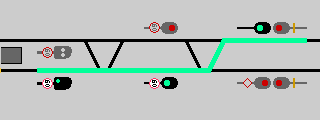
As with traditional signaling, several higher speed exit routes may
be signaled identically by the "Proceed Through" aspect in the Platform
Exit Signal:
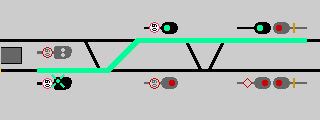
Platform Exit Signals
as Station Block Signals
The Copenhagen Airport station, Kastrup, features an unusual arrangement,
in which Platform Exit Signals are used as independent "station block signals"
when running between the platforms and the maintenance and cleaning facility:

The unusual use of the Platform Exit Signal means that a train may be
signaled to proceed from one Platform Exit Signal to the next by the "Proceed"
aspect:


In traditional Danish signaling the "Proceed" aspect from a Platform
Exit Signal means that following Platform Exit Signals also show "Proceed"
(or better), and that the first possible signal at "Stop" is the Exit or
Exit Block Signal. The use of Platform Exit Signals as Station Block Signals
is not in itself contradictory to ordinary signaling rules, only to the
practice applied so far. Until a few years ago, however, the Nyborg ferry
station featured a similar arrangement for trains traveling between the
ferry platforms and the ordinary station platforms.
No advance signaling is given when traveling from Platform Exit Signal
to Platform Exit Signal:


Only when the traditional conditions are fulfilled (clear past the Exit
Signal) may the Platform Exit Signals show "Proceed Through":

To or From Ordinary Signaling
Transition between ordinary signaling and Reduced Lineside Signaling takes
place at stations. The stations use ordinary signaling. The first "reduced"
signal when traveling towards the Reduced Lineside Signaling is the station
Exit Signal; the first ordinary signal coming back is the station Entry
Signal:

Trains traveling towards the Reduced Lineside Signaling experiences
ordinary signaling through the transition station. The Exit Signal, however,
only shows "Proceed", as this is a "reduced" signal:

Trains leaving the Reduced Lineside Signaling sees the last Automatic
Block Signal as the last "reduced" signal, as the transition station Entry
Signal displays ordinary aspects:

Peculiarities
Reduced Lineside Signaling is really to be considered a peculiarity in
itself.


![]()
























































![]()
![]()